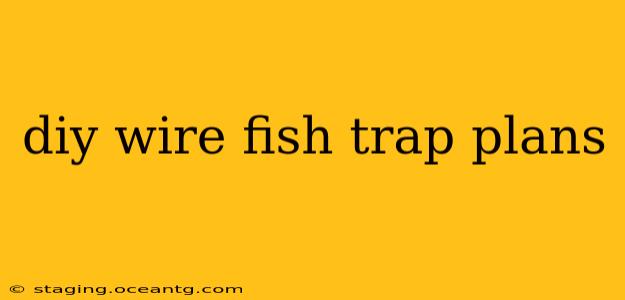Catching fish has been a human activity for millennia, and building your own fishing traps offers a rewarding blend of ingenuity and resourcefulness. This comprehensive guide provides detailed DIY wire fish trap plans, covering everything from materials to construction techniques, ensuring you can create effective and sustainable traps. We’ll even address common questions surrounding these homemade traps.
What Materials Do I Need to Build a Wire Fish Trap?
The beauty of a DIY wire fish trap lies in its simplicity; you don't need expensive, specialized equipment. The core components are readily available at most hardware stores. You'll primarily need:
- Heavy-gauge wire: Galvanized wire is a popular choice due to its durability and resistance to rust. The gauge will depend on the size of fish you intend to target; thicker wire is better for larger fish. Aim for a gauge between 12 and 16.
- Wire cutters: A sturdy pair of wire cutters is essential for precise cutting and shaping.
- Pliers: Several types of pliers can be useful, including needle-nose pliers for intricate work and lineman's pliers for bending and twisting heavier wire.
- Measuring tape: Accurate measurements are crucial for building a functional trap.
- Optional: Welding equipment: For stronger, more durable connections, welding can be employed, but it's not strictly necessary.
What Are the Different Types of Wire Fish Traps?
Several designs for wire fish traps exist, each with its own advantages and disadvantages. The most common include:
- Funnel Trap: This design utilizes a cone-shaped entrance that allows fish to enter easily but makes it difficult for them to exit. It's relatively simple to construct.
- Hoop Trap: This trap uses a series of hoops connected to create a chamber. It's more complex to build but can be more effective in certain situations.
- Miniature Trap: Great for smaller fish or crustaceans, these traps are smaller versions of the funnel or hoop designs.
How Do I Build a Simple Funnel Wire Fish Trap?
This section will detail the construction of a basic funnel trap. Remember, safety is paramount. Always wear appropriate safety glasses when working with wire.
- Cut the Wire: Cut lengths of wire according to your chosen dimensions. The dimensions will depend on the size of the fish you're targeting. For a smaller trap, you might start with lengths around 12-18 inches.
- Create the Frame: Bend the wire into a roughly conical shape, forming the main body of the trap. Overlapping and twisting the ends together securely will create the frame. You can use pliers to create tighter joints.
- Form the Funnel: Use additional wire to construct a funnel-shaped entrance at the narrow end of the cone. This should be narrow enough to prevent fish from easily escaping but wide enough for them to enter. Securely attach this funnel to the main frame.
- Add a Neck: To prevent fish from escaping, create a ‘neck’ using wire, constricting the opening slightly.
- Set the Trap: Securely fasten a line to the trap's top for retrieval.
How Do I Build a More Complex Wire Fish Trap?
More complex designs often involve multiple chambers or intricate entryways, making them more challenging to construct but potentially more efficient. These designs often require welding or more robust wire connections for durability. Detailed plans for these advanced designs can be found online from experienced fish trappers and DIY enthusiasts. Always prioritize safety when working with more intricate designs.
How Often Should I Check My Wire Fish Trap?
The frequency of checking your trap depends on several factors, including the water temperature, the density of fish in the area, and the size of the trap. Check your trap at least once daily, but you might need to check it more frequently in optimal conditions. Overcrowding can stress the fish and reduce their survival rate.
What are the Legal Regulations for Using Fish Traps in My Area?
Before you start building and using your fish trap, it's crucial to research the local fishing regulations in your area. Rules regarding trap size, placement, and the types of fish you can catch vary significantly. Check with your local wildlife or fisheries department for specific guidelines to ensure you're fishing legally and sustainably.
Are There Any Ethical Considerations I Should Keep in Mind?
While building and using fish traps can be a fun and sustainable way to catch fish, ethical considerations are paramount. Always practice catch and release if you don't intend to consume the fish, minimizing any harm to the animals. Use traps responsibly and avoid overfishing. Sustainable fishing practices are essential for maintaining healthy fish populations.
This guide provides a starting point for your DIY wire fish trap journey. Remember to research further, adapt plans to your needs and local conditions, and always prioritize safety and ethical considerations. Happy fishing!
